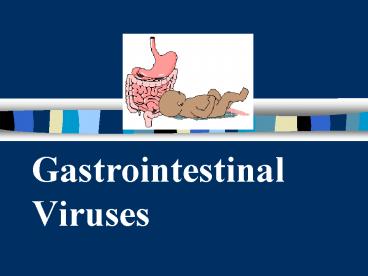Gastrointestinal Viruses PowerPoint PPT Presentation
1 / 25
Title: Gastrointestinal Viruses
1
Gastrointestinal Viruses
2
Viral Gastroenteritis
- It is thought that viruses are responsible for
up to 3/4 of all infective diarrhoeas. - Viral gastroenteritis is the second most
common viral illness after upper respiratory
tract infection. - In developing countries, viral gastroenteritis is
a major killer of infants who are
undernourished. Rotaviruses are responsible for
half a million deaths a year. - Many different types of viruses are found in the
gut but only some are associated with
gastroenteritis.
3
Associated with gastroenteritis
- Rotaviruses
- Adenoviruses 40 41
- Caliciviruses????
- Norwalk like viruses or SRSV (Small Round
Structured Viruses) - Astroviruses
- SRV (Small Round Viruses)
- Coronaviruses
- Toroviruses
4
Found in the gut, not normally associated with
gastroenteritis
- Polio
- Coxsackie A
- Coxsackie B
- Echo
- Enteroviruses 68-71
- Hepatitis A
- Hepatitis E
- Adenoviruses 1-39
- Reoviruses
5
Found in the gut as opportunistic infection
- CMV
- HSV
- VZV
- HIV
6
Gastrointestinal Viruses
Virus Genome Typical disease incubation Duration
Rotaviruses Group A, B, C ds-segmented RNA Major cause of diarrhea in children 1-3 days 24-56 h 5-8 days 3-7 days
Caliciviruses Norwalk agents ssRNA Infects adults and children Epidemic viral gastroenteritis 1-3 days 18-24 h 1-3 days 12-48 h
EAd 40,41 Linear dsRNA diarrhea in children 7-8 days 8-12 d
Astrovirus ssRNA Infects mainly children and elderly 1-4 days 1-4 d
7
Gastrointestinal Viruses
- Infants
- Rotavirus A Adenovirus 40,41
Coxsackie A24 virus - Infants, children, and adults
- Norwalk virus Calicivirus????
astrovirus Rotavirus B Reovirus.
8
Human Rotavirus
9
Important Characteristics
- 70 nm round, double shelled, enclosing a genome
of 11 segments of double stranded RNA.
10
(No Transcript)
11
Groups of Rotaviruses
- Group A subtypes 1, 2, 3, 4 (main human
pathogens)(Further 7 subtypes) also infect
animals (monkey, calf, mouse) - Group B Infects pigs and ratsFound to cause
extensive outbreaks in China in past decade - Group C Infects Pigs (Occasionally Man)
- Group D Infects birds
- Group E Infects pigs
12
(No Transcript)
13
Pathogenesis
- Essentially an ingestion disease (faecal-oral
route) - Incubation is short 1 to 3 days
- Illness Sudden onset watery diarrhoea, with or
without vomiting. May last up to 6 days (or
longer if immunocompromised). The disease is self
limiting. - Complications Dehydration may result, this can
be severe and life threatening in young children.
14
Pathogenesis
- Group A Main pathogen of infantile diarrhea
- Group B Cause epidemic adult diarrhea
- Group C Cause human or animal sporadic diarrhea
15
(No Transcript)
16
ImmunitysIgA
- Lab. Diagnosis
- IEM,
- Cell culture,
- PAGE of RNA segments,
- PCR
- Latex agglutination
- ELISA
17
Treatment
- treatment of dehydration by oral and/or
intravenous fluids and electrolytes
18
Prevention
- Non specific factors improved hygiene,
education, clean waterSpecific - Breast feeding
helps to provide passive immunity in the newborn
(from maternal antibodies), Vaccination is still
experimental.
19
Enteric Adenoviruses
- Naked DNA viruses, 75 nm in diameter.
- Fastidious enteric adenovirus types 40 and 41
are associated with gastroenteritis. - Associated with cases of endemic
gastroenteritis, usually in young children and
neonates. Can cause occasional outbreaks. - Possibly the second most common viral cause of
gastroenteritis (7-15 of all endemic cases). - Similar disease to rotaviruses
- Most people have antibodies against enteric
adenoviruses by the age of three. - Diagnosed by electron microscopy or by the
detection of adenovirus antigens in faeces by
ELISA or other assays.
20
Astroviruses
- Small RNA viruses, named because of star-shaped
surface morphology, 28 nm in diameter. - Associated with cases of endemic
gastroenteritis, usually in young children and
neonates. Can cause occasional outbreaks. - Responsible for up to 10 of cases of
gastroenteritis. - Similar disease to rota and adenoviruses.
- Most people have antibodies by the age of three.
- Diagnosed by electron microscopy only, often
very difficult because of small size.
21
Caliciviruses
- Small RNA viruses, characteristic surface
morphology consisting of hollows. particles 35
nm in diameter. - Associated mainly with epidemic outbreaks of
gastroenteritis, although occasionally
responsible for endemic cases. - Like Norwalk type viruses, vomiting is the
prominent feature of disease. - Majority of children have antibodies against
caliciviruses by the age of three. - Diagnosed by electron microscopy only, often
difficult to diagnose because of small size.
22
Norwalk-like Viruses
- Small RNA viruses, with ragged surface, 35 nm in
diameter, now classified as caliciviruses. - Always associated with epidemic outbreaks of
gastroenteritis, adults more commonly affected
than children. - Associated with consumption of shellfish and
other contaminated foods. Aerosol spread possible
as well as faecal-oral spread. - Also named "winter vomiting disease", with
vomiting being the prominent symptom, diarrhoea
usually mild. - Antibodies acquired later in life, in the US,
only 50 of adults are seropositive by the age
of 50. - Diagnosis is made by electron microscopy and by
PCR.
23
(No Transcript)
24
Other Possible Diarrhoeal Viruses
- Coronaviruses
- RNA viruses with a crown-like appearance
- Not convincing associated with gastroenteritis at
present - Small Round Viruses
- Small virus-like particles with a smooth
surface, 22-28nm in diameter - May possibly be parvoviruses, enteroviruses, or
cubic bacteriophages - Occasionally seen in the faeces of endemic or
epidemic cases of gastroenteritis
25
Gastrointestinal Viruses
Virus Genome Typical disease incubation Duration
Rotaviruses Group A, B, C ds-segmented RNA Major cause of diarrhea in children 1-3 days 24-56 h 5-8 days 3-7 days
Caliciviruses Norwalk agents ssRNA Infects adults and children Epidemic viral gastroenteritis 1-3 days 18-24 h 1-3 days 12-48 h
EAd 40,41 Linear dsRNA diarrhea in children 7-8 days 8-12 d
Astrovirus ssRNA Infects mainly children and elderly 1-4 days 1-4 d

